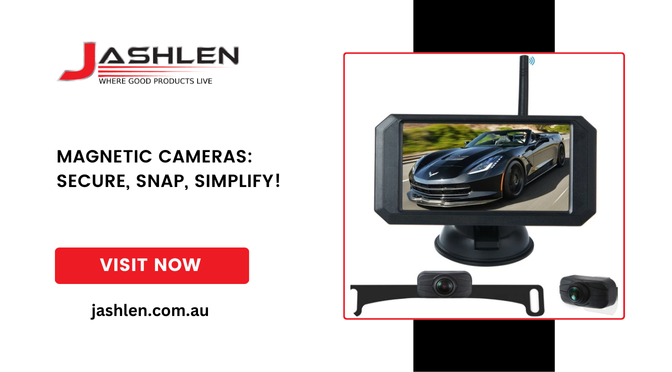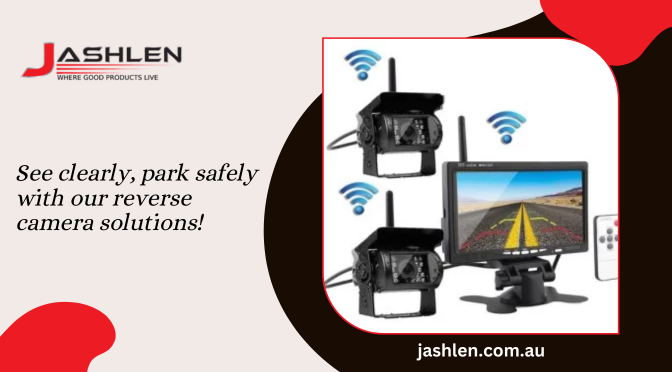Step into the future of reversing safely with magnetic cameras. In this ultimate guide, we will unveil the power and convenience of these innovative devices.
With a maximum word count of 160, we’ll dive deep into the features and benefits of magnetic cameras, providing you with everything you need to know to make an informed purchase decision.
From easy installation to seamless integration with your existing setup, magnetic cameras offer a flexible solution for any vehicle. Their magnetic base allows for quick and secure attachment to any metal surface, eliminating the need for drilling or complicated mounting brackets.
Our guide will also explore the advanced technology behind these cameras, including high-resolution imaging capabilities and wide-angle lenses, ensuring optimal visibility and clarity when maneuvering in tight spaces.
Moreover, we’ll discuss the various applications of magnetic cameras beyond reversing, such as trailer hitching, parking assistance, and surveillance.
Join us as we unleash the power of magnetic cameras and drive confidently in reverse. Get ready to revolutionize your driving experience with this ultimate guide.
The importance of reversing safely
Reversing a vehicle safely is a critical skill that every driver should master. It may seem like a simple task, but the reality is that reversing can be fraught with dangers, especially in crowded parking lots or tight spaces. According to statistics, a significant percentage of accidents occur while reversing, often resulting in injuries or property damage. Understanding the importance of reversing safely can help drivers mitigate these risks and ensure a safer driving experience for everyone involved. By prioritizing safe reversing practices, drivers can protect themselves, their passengers, and pedestrians alike.
The act of reversing involves navigating in a direction that is often out of the driver’s direct line of sight. This can lead to blind spots that obscure the presence of obstacles or pedestrians. Traditional rearview mirrors and side mirrors provide limited visibility, which is why many vehicles are now equipped with backup cameras and sensors. However, these technologies are not foolproof. The addition of magnetic cameras enhances the visual perspective while reversing, offering a wider field of view and higher resolution images. This can dramatically reduce the chances of accidents occurring during this critical maneuver.
Moreover, the safety implications of reversing extend beyond just avoiding collisions. Drivers can also avoid costly damages to their vehicles or the property of others. This not only protects one’s financial interests but also fosters a more responsible driving culture. As urban areas become denser and parking spaces more compact, the need for effective reversing solutions becomes increasingly evident. By utilizing advanced technologies like magnetic cameras, drivers can navigate their vehicles with greater precision and confidence, leading to a safer driving environment for everyone.
Understanding the technology behind magnetic cameras
Magnetic cameras represent a significant advancement in reversing technology, combining high-resolution imaging with the convenience of magnetic mounting. These cameras are equipped with wide-angle lenses, which offer a broader field of view compared to traditional rearview cameras. This allows drivers to see more of their surroundings when reversing, thereby reducing blind spots that can lead to accidents. The ability to capture clear images in various lighting conditions is another crucial feature that enhances safety during reversing maneuvers.
The technology behind magnetic cameras often includes features such as night vision capabilities, which enable drivers to reverse safely even in low-light conditions. By utilizing infrared sensors and high-quality lenses, these cameras can produce clear images regardless of the time of day. Additionally, many magnetic cameras come with built-in image stabilization technology, which minimizes the effects of vehicle vibrations, ensuring that the driver gets a steady and clear view of what’s behind them.
Another key aspect of magnetic cameras is their ease of integration with existing vehicle systems. Many models are designed to connect wirelessly to smartphones or vehicle displays, making it easy for drivers to view the camera feed in real-time. This seamless integration means that drivers can quickly adapt to using these cameras without the need for extensive modifications to their vehicles. Overall, understanding the technology behind magnetic cameras reveals their potential to revolutionize the way drivers approach reversing, making it a safer and more efficient process.
Benefits of using magnetic cameras for reversing
One of the primary benefits of using magnetic cameras for reversing is the increased safety they offer. With a wider field of view and better image clarity, these cameras enable drivers to identify potential hazards that may not be visible through traditional mirrors. This is particularly useful in urban environments where pedestrians, cyclists, and other vehicles can quickly appear in the driver’s line of sight. By providing a clearer picture of the surroundings, magnetic cameras help reduce the likelihood of accidents and improve overall driving safety.
Another significant advantage is the convenience that comes with the magnetic mounting system. Unlike permanent camera installations that require drilling and complex wiring, magnetic cameras can be easily attached to any metal surface on a vehicle. This means that drivers can quickly reposition the camera as needed, whether they are using it for reversing, trailer hitching, or parking assistance. The flexibility of magnetic cameras makes them an attractive option for drivers who may need to change their setup frequently.
Furthermore, magnetic cameras are often designed to be durable and weather-resistant, ensuring that they can withstand various environmental conditions. This durability means that drivers can rely on these cameras regardless of the weather, whether it’s raining, snowing, or sunny. The combination of safety, convenience, and durability makes magnetic cameras an essential tool for modern drivers who want to enhance their reversing capabilities and minimize risks on the road.
Choosing the right magnetic camera for your vehicle
When selecting a magnetic camera for your vehicle, it’s essential to consider several factors to ensure you choose the right model for your specific needs. First and foremost, assess the resolution of the camera. Higher resolution cameras provide clearer images, which can make a significant difference when reversing in tight spaces. Look for cameras that offer at least 1080p resolution, as this will ensure you can see details clearly, even at a distance.
Next, consider the features offered by different camera models. Some magnetic cameras come with additional functionalities such as motion detection, night vision, or even built-in GPS. These features can enhance the overall utility of the camera and provide added peace of mind while driving. For example, night vision capabilities can be beneficial for those who often find themselves reversing in low-light conditions, while motion detection can alert drivers to moving objects behind the vehicle.
Lastly, compatibility with your vehicle is crucial. Ensure that the magnetic camera you choose can connect easily to your existing monitoring system, whether it’s a built-in display or a smartphone app. Many magnetic cameras are designed for universal compatibility, but it’s always a good idea to check the specifications to avoid any issues during installation. By taking the time to choose the right magnetic camera, you can significantly improve your reversing experience and enhance your overall driving safety.
Installation and setup of magnetic cameras
Installing a magnetic camera is a straightforward process that can typically be completed in just a few minutes. First, you need to identify the best location on your vehicle for the camera. Ideally, it should be positioned to provide an unobstructed view of the area directly behind the vehicle. Common mounting spots include the rear of the vehicle or the trunk lid. Once you’ve selected a location, clean the surface thoroughly to ensure a secure attachment.
After preparing the mounting surface, simply place the magnetic camera onto the metal surface and ensure it adheres securely. Most magnetic cameras come with strong magnets that provide a reliable hold, even during driving. If your camera requires a power source, follow the manufacturer’s instructions to connect it to your vehicle’s power system. Many models are designed to operate on battery power, which can simplify the installation process even further.
Once the camera is mounted and powered on, the next step is to connect it to your display device, whether it’s a built-in screen, a smartphone, or a tablet. Most modern magnetic cameras feature wireless connectivity options, allowing for a seamless connection. After pairing the camera with your display device, take the time to adjust the camera angle for optimal visibility. With everything set up correctly, you can now enjoy the enhanced safety and convenience that magnetic cameras provide when reversing your vehicle.
Tips for using magnetic cameras effectively
To maximize the benefits of your magnetic camera, it’s important to use it effectively while reversing. One key tip is to always check the camera feed before beginning to reverse. Take a moment to observe the surrounding environment through the camera, as this will help you identify potential obstacles or hazards that may not be visible from your mirrors. Familiarizing yourself with the camera’s view can significantly enhance your awareness when backing up.
Another important aspect of using magnetic cameras is to combine their use with traditional methods of reversing. While these cameras provide valuable visual information, they should not replace the fundamental practice of checking mirrors and looking over your shoulder. By using a combination of visual aids, you can develop a more comprehensive understanding of your surroundings, leading to safer reversing maneuvers.
Finally, ensure that your camera is always clean and free from obstructions. Dirt, snow, or ice can obscure the camera lens, reducing visibility and rendering the camera less effective. Regularly inspect the camera to ensure it’s functioning correctly, and clean the lens as needed. By following these tips, you can make the most out of your magnetic camera, enhancing your reversing safety and overall driving experience.
Common mistakes to avoid when using magnetic cameras for reversing
While magnetic cameras are designed to enhance safety, there are common mistakes that drivers should avoid to ensure they are using these devices effectively. One significant error is relying solely on the camera for reversing without utilizing other aids, such as mirrors. The camera provides a valuable perspective, but it’s essential to maintain awareness of your surroundings through traditional methods. Failing to do so can lead to accidents, especially if there are pedestrians or other vehicles in blind spots.
Another mistake is neglecting to adjust the camera angle before reversing. If the camera is not positioned correctly, it may not capture the area directly behind the vehicle, leading to misjudgments while backing up. Before starting the vehicle, take a moment to ensure the camera provides a clear view of the intended path. This simple adjustment can make a significant difference in preventing accidents and ensuring safe reversing.
Additionally, some drivers may overlook the importance of regular maintenance for their magnetic cameras. It’s vital to periodically check the camera for any damage or wear, as well as to keep the lens clean. If the camera is obstructed by dirt, snow, or debris, its effectiveness diminishes significantly. Regularly inspecting and maintaining your camera will ensure that it continues to provide reliable performance, helping you reverse safely every time you get behind the wheel.
Maintenance and troubleshooting of magnetic cameras
Proper maintenance of magnetic cameras is essential to ensure their longevity and effectiveness. Regularly inspect the camera for any signs of wear and tear, especially after exposure to harsh weather conditions. Check for any loose connections or damage to the mounting surface. If the camera becomes loose, it may not provide the intended view, which can compromise safety during reversing. Keeping the camera securely attached and functioning optimally is crucial for safe operation.
Cleaning the camera lens is another vital maintenance task. Dirt, grime, and moisture can accumulate on the lens and obstruct the view, leading to poor image quality. Use a soft, lint-free cloth to gently wipe the lens, ensuring that it remains clear and unobstructed. In cases of heavy snow or ice, allow the camera to thaw before cleaning, as attempting to remove ice while it’s still frozen can cause damage. Regular cleaning will help maintain high-resolution imaging and clear visibility.
In the event of troubleshooting, start by checking the power source and connections. If the camera is not functioning properly, ensure that it is securely connected to the power supply. For wireless models, verify the connection between the camera and the display device. If issues persist, consult the manufacturer’s manual for guidance on specific troubleshooting steps. By staying proactive with maintenance and addressing issues promptly, you can ensure that your magnetic camera remains a reliable tool for safe reversing.
Conclusion and final thoughts on reversing safely with magnetic cameras
In conclusion, magnetic cameras are a game-changing tool for enhancing safety while reversing. Their advanced technology, combined with the convenience of magnetic mounting, allows drivers to navigate tight spaces with confidence. By understanding the importance of reversing safely and utilizing the features of magnetic cameras, drivers can significantly reduce the risks associated with backing up.
Choosing the right magnetic camera for your vehicle, ensuring proper installation, and following best practices can lead to a safer and more efficient driving experience. Remember that using the camera effectively involves combining it with traditional methods, maintaining it regularly, and avoiding common mistakes. By integrating these practices, drivers can maximize the benefits of magnetic cameras and transform their reversing experience.
As we embrace the future of driving technology, it’s clear that magnetic cameras are at the forefront of improving safety on the roads. Whether you’re a seasoned driver or a newcomer, investing in a magnetic camera can provide peace of mind and enhance your overall driving skills. By unleashing the power of these innovative devices, you can navigate your vehicle with greater safety and assurance, making every reversing maneuver a breeze.






